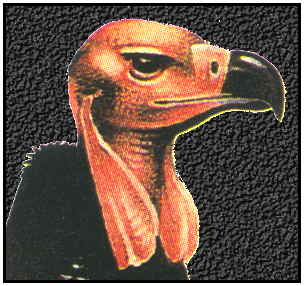PondicherryOrder: Falconiformes. Family: Accipitridae. (Old World vulture). Scientific Name: Sarcogyps calvus. Common Names: Pondicherry Vulture, Red-headed Vulture, Indian Black Vulture. Conservation Status: Threatened. Rescue & Recovery: Zoo breeding programmes and studies in the wild to try and determine why the numbers of birds are reducing. This seems to be the same illness affecting other vultures of this area, possibly a virus, deliberate poisoning, lack of food due to the now-common practice of burying carcasses, or another as yet unidentified cause. At this stage several species of vulture are in grave danger of extinction unless the root cause of this problem can be identified and eradicated. Geographical Range: India, Thailand, Laos, China, Burma and South Yunnan. Habitat: Jungles, forests, woodlands. Prefers damp areas.
Pondicherry VulturePhysical Characteristics: This vulture is about 75 centimetres long, with a wing span of 2.7 metres. They are a very dark brown, (almost black), with a black collar, two white patches of down above the thighs, and some white on the wing which is only visible during extension. The skin on the head varies from red through to orange and the iris also varies, being either red, brown or yellow. The Pondicherry Vulture has a large, powerful black bill, red cere, feet and legs. Immature birds are brown with some areas of black on the wings. Their heads and throats are covered with white down and the iris is brown, The cere, feet and skin areas are red, however this is paler than in adult birds. The Pondicherry Vulture is one of the more vocal species, but only during the breeding season when it produces loud roaring noises when displaying or mating. Food: Carrion. Reproduction: Mating displays include much soaring, diving and twisting by both male and female. They usually choose to nest in tall trees, but will happily use low bushes if there are no tress in the area. Though they do not nest in colonies of their own species they will happily nest in trees occupied by other vulture types. The same nests are used each year and start off rather small and flimsy, growing over time to become large and sturdy at around five feet across. Both birds take part in building the nest with the male providing sticks, hair and rubbish which the female uses to construct the nest. One particularly smooth egg is laid, either pale green or white. Both parents share in the 45 day incubation with the female taking the nights and the male the daylight hours. During the swap over period the birds vocalise loudly.
|

